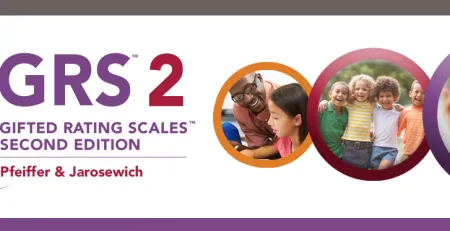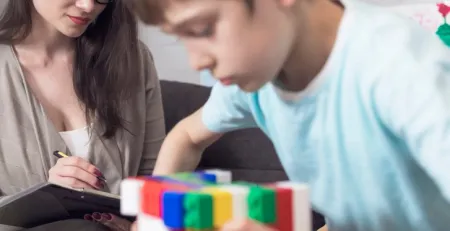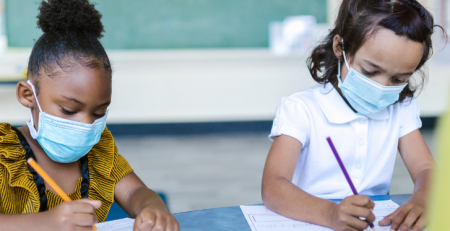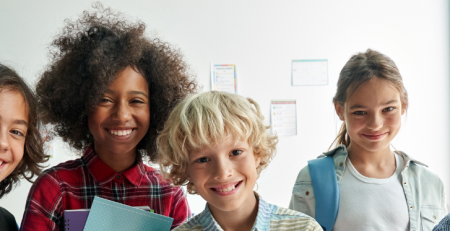Shining Bright: Understanding and Supporting Twice-Exceptional Youth
The true story shared below captures the ongoing journey of a remarkable boy and his parents as they navigate the complexities of growing up with a unique blend of gifts and challenges, a blend that makes him twice-exceptional.
A student’s journey
“My son is three, and he is a wonder. He never stops. The world won’t hold him back. He can’t get information that is heavy enough to satisfy him or fast enough to catch his little mind. We mostly work to keep him safe, reminding him repeatedly to look before he leaps. We talk about his feelings late at night when his thoughts get quiet. Is he like other kids? I don’t know, but he is special to us.
My son is five, and he loves school. He loves his classmates, recess, worksheets, and circle time and adores his teacher. She gets him, makes space for him to wiggle, reminds him to blow bubbles to control his breath, and gives him big hugs. He understands how everything works together; he can read, write stories, and solve math problems. He still crosses the street without looking and disappears when he should stay close. My hand grips his tightly wherever we go. He’s physically and mentally strong; he understands but doesn’t listen. What are we missing?
My son is seven, and he is kind. He notices how others are treated, and it bothers him when people aren’t genuine. He does everything with an intensity that could fuel the sun: learning, growing, and playing. How can so much energy make us so tired? His teachers have been talking, but not to us. He learns fast, but his behavior is a problem; he loses recess and field days. Every day, we talk about making good choices and controlling his body, and he commits to trying even harder. One night, he whispers to me his fear: “I’m different than the other kids. No matter how hard I try, I keep messing up; I don’t think I’m a good boy.” We need help; we go to his teachers and doctor and talk to friends with experience. We receive the diagnosis of Attention-Deficit/Hyperactivity Disorder (ADHD). We begin to shift from controlling his behavior to exploring his neurodivergence. He is not ashamed to talk about his ADHD, his counseling, and his medication. He is resilient and he is learning about himself.
My son is nine, and he is brilliant. He loves big vocabulary words, complicated math problems, and playing flag football with his friends. The crossing guards save his life when he rushes across the street without looking. Things around him go too slowly, and we work on strategies to help him compensate. His teacher sees him; she makes space for him to move, for his silly noises and big questions, and space for him to advance academically. She suspects he is gifted; he was tested for this, years before in a large group, his scores were low, and his behavior was challenging. This time, he is happy and excited, and he knows we all believe in him. His scores on the academic and ability tests are very high, and he is identified as gifted. We are not surprised but we are relieved. His confidence grows, we begin to focus on his strengths, we recognize the ways his giftedness and his ADHD interact with each other. He shines so brightly that, all around him, the clouds begin to clear.”
What is twice-exceptionality?
The boy described in the story above is a child who is considered to be twice-exceptional (2e). 2e is a term used to describe intellectually gifted children who have one or more diagnoses, such as dyslexia, ADHD, or autism spectrum disorder, among others. Students who are 2e display a complex profile of characteristics, with notable strengths in certain areas and challenges in others, making them one of the most under-identified and under-served populations in school settings. Some common characteristics of 2e children may include1:
High aptitude in one or more areas of cognitive functioning:
- Exceptional critical thinking and problem-solving skills
- Strengths in reasoning, verbal, and/or spatial abilities
- High levels of creativity
- Superior vocabulary
- Rapid learning
Difficulties with reading, mathematics, writing, and/or spelling due to cognitive processing deficits:
- Slow processing speed
- Difficulties with short-term/working memory
Social, emotional, and behavioral challenges:
- Difficulties with social interactions
- Poor self-concept
- High levels of anxiety
- Emotional dysregulation
- Poor organizational skills
- Low motivation
What makes the identification of twice-exceptional students challenging?
Despite some commonalities, it is important to note that 2e students are a diverse group and can vary significantly from one another in terms of their strengths and challenges. Moreover, the discrepancy between their cognitive gifts and talents and their cognitive processing difficulties or social, emotional, or behavioral challenges means that these gifted students may not be able to demonstrate their actual abilities in the classroom. Typically, 2e students can fall into one of three categories:
- For some students who are 2e, their disabilities are masked by their superior cognitive functioning, so they do not get diagnosed with a disorder. These students are often not high achieving in the classroom and may show poor self-concept and lack motivation. They typically go unnoticed until they enter higher grade levels when the curriculum becomes more challenging.
- For other 2e students, their giftedness may be obscured by their disability. These students are often missed in the gifted testing process. Their potential and unique instructional needs go without being met as interventions focus on remediating the challenges related only to their disability.
- Finally, for the last group of 2e students, neither their giftedness nor disability are ever identified because each exceptionality conceals the other. Such students go through their education appearing to function as an average or typical student, often missing out on enrichment opportunities and effective treatments or programs to help accommodate their limitations2,3.
In every case, the profile of 2e students is complex, and the impact of not identifying that complexity is the loss of opportunity. These students are not able to access a learning environment that fosters their full potential.
How can you identify twice-exceptionality?
Given how complex twice-exceptionality can be, experts recommend a multi-dimensional approach to identifying the various facets of 2e students. Specifically, standardized assessments of intellectual potential, achievement, and potential areas of disability are indicated 4. These critical needs for identification align with MHS’ portfolio of behavioral and gifted assessment measures.
The assessment and evaluation process should include measures that look at students’ social, emotional, and behavioral functioning. For example, the Conners Comprehensive Behavior Rating Scales™ (Conners CBRS™) helps determine the presence of social, emotional, behavioral, or academic difficulties in youth. It is a multi-informant tool that measures functioning and impairment at home, school, and social settings. In addition, narrow-band tools can provide greater insight when investigating the full picture of a youth’s functioning. If results suggest the presence of attention problems, consider the Conners 4th Edition (Conners 4™), which provides a comprehensive assessment of symptoms and impairments associated with ADHD and common co-occurring problems and disorders. If an autism spectrum disorder is a possibility, the Autism Spectrum Rating Scales™ (ASRS) can help identify associated symptoms, behaviors, and features. Concerns with anxiety and/or depression can be evaluated using the Multidimensional Anxiety Scale for Children Second Edition™ (MASC 2™) and the Children’s Depression Inventory 2nd Edition™ (CDI 2®), which measure severity of symptoms and aid in early identification of anxiety, depression and related disorders in youth.
The assessment process should provide an in-depth look at cognitive ability using an inclusive measure that accounts for language and cultural differences. A tool like the Naglieri General Ability Tests, which were built around the guiding principle that giftedness is a function of how a child thinks, not how much they know, provides insight into a student’s ability to approach and solve complex problems, regardless of their previous experiences, learning opportunities, or associated knowledge. Three separate tests measure general intellectual ability across verbal, nonverbal, and quantitative domains using test items carefully designed to allow students to solve problems regardless of the language they speak, the formal knowledge they have been exposed to, their ability to respond verbally, or their cultural background. This careful approach to test creation provides a measure of general intellectual ability that is as fair and equitable as possible.
When reviewing these results, particular attention should be paid to variability within skills and asynchronous development of general intellectual ability. A standardized measure for parents and teachers, such as the Gifted Rating Scales™ Second Edition (GRS™ 2), gives users additional data on intellectual ability and academic ability as well as other important areas, such as creative/artistic ability, leadership, motivation, resiliency, and social competency. The multi-informant tool enables a holistic view of the student’s abilities across home and school environments. It provides stakeholders with greater understanding to foster the potential of students who are 2e. In addition, the Comprehensive Executive Function Inventory™ (CEFI®) provides a complete profile of executive function strengths and weaknesses for a youth. These skills are essential for problem solving and reasoning, and difficulties with them may make simple tasks much more challenging. Having this information is an important step towards not just identification but building a plan for supporting students who are twice-exceptional.
How can we better support 2e kids?
Once their unique needs are identified, setting up the appropriate support system for a student who is 2e might involve a variety of strategies and resources. Individualized formal education plans provide services, accommodations and access to curriculum, gifted programming fosters areas of strength or high interest (e.g., art, music, engineering), and emotional and behavioral skill-building supports social development. Experts recommend using a strengths-based approach that looks at the whole child, starting with their gifted talents and supporting those needs, while also recognizing the importance of providing appropriate support for areas in which they face challenges. By adopting a strengths-based perspective that acknowledges both their gifts and challenges, we can empower 2e students to embrace their full potential, while addressing any self-concept hurdles they may encounter, ultimately guiding them towards success and fulfillment.
References
[1] Maddocks, D. L. (2020). Cognitive and achievement characteristics of students from a national sample identified as potentially twice exceptional (gifted with a learning disability). Gifted Child Quarterly, 64(1), 3-18.
[2]Foley‐Nicpon, M., & Assouline, S. G. (2020). High ability students with coexisting disabilities: Implications for school psychological practice. Psychology in the Schools, 57(10), 1615-1626.
[3] Gilman, B. J., Lovecky, D. V., Kearney, K., Peters, D. B., Wasserman, J. D., Silverman, L. K., … & Rimm, S. B. (2013). Critical issues in the identification of gifted students with co-existing disabilities: The twice-exceptional. Sage Open, 3(3), 2158244013505855.
[4] NAGC (2013). Ensuring Gifted Children with Disabilities Receive Appropriate Services: Call for Comprehensive Assessment. National Association for Gifted Children. https://cdn.ymaws.com/nagc.org/resource/resmgr/knowledge-center/position-statements/ensuring_gifted_children_wit.pdf










